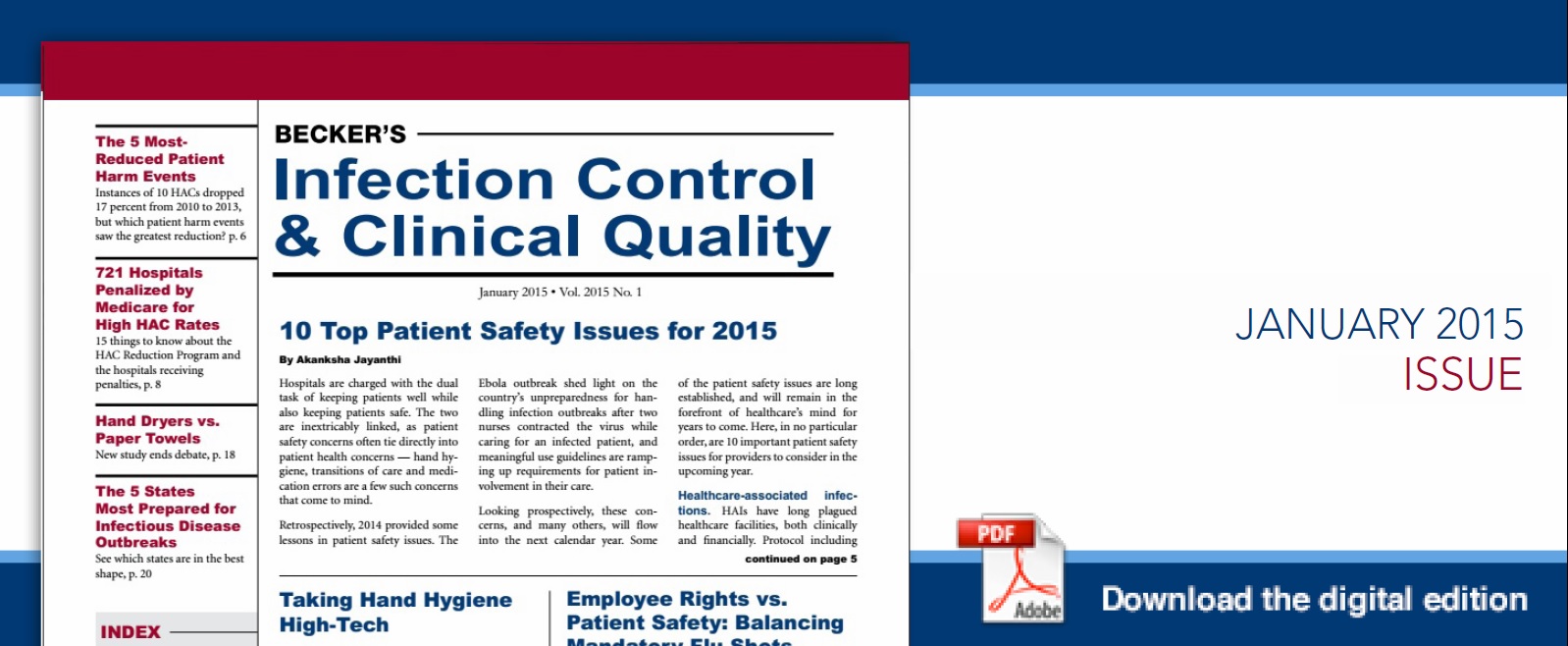January/February 2015 Issue of Becker's Infection Control and Clinical Quality
On the Cover
|
|
10 Top Paitent Safety Issues for 2015 |
|
|
Taking Hand Hygiene High-Tech |
|
Employee Rights vs. Patient Safety: Balancing Mandatory Flu Shots |
Patient Safety
ECRI Institute: Top 10 Technology Patient Safety Hazards
Several facets of health IT have a positive impact on patient outcomes, like automated reminders that improve medication adherence. Click here to continue >>
Patient Harms Fall 17% Since 2010: Are Federal Incentives Working?
In 2010, the healthcare community was tasked with improving quality measures through a series of initiatives, including Medicare payment incentives and HHS' Partnership for Patients. Click here to continue >>
The 5 Most-Reduced Patient Harm Events
Instances of 10 healthcare-acquired conditions in the U.S. from 2010 to 2013 dropped 17 percent, but the nation made greater strides in reducing some patient harm events than in others. Click here to continue >>
790 Hospitals Earn "A" Patient Safety Grades From Leapfrog
The Leapfrog Group has released the fall 2014 update to its Hospital Safety Score, assigning grades of A, B, C, D or F to hospitals based on 15 process measures and 13 outcome measures. Click here to continue >>
Physicians Rarely Apologize After Patient Adverse Events, Survey Finds
Most patients who experience an adverse event in the hospital receive neither an acknowledgment of the incident nor an apology from the physician, according to a study based on a ProPublica survey and published in the Journal of Patient Safety. Click here to continue >>
721 Hospitals Penalized by Medicare for High Hospital-Acquired Conditions Rates
In fiscal 2015, 721 hospitals will have their Medicare payments reduced for being among the 25 percent of hospitals with the highest rates of hospital-acquired conditions. Click here to continue >>
10 States Hit Hardest by Medicare Hospital Infection Fines
In fiscal year 2015, 721 hospitals will have their Medicare payments reduced as part of the Hospital-Acquired Conditions Reduction Program because they are among the 25 percent of hospitals with the highest rates of HACs. Click here to continue >>
What Drives a Patient to Report a Medical Error?
A recent survey of adults in Massachusetts showed 23% had experienced a medical error or someone close to them did — but just 54 percent of those people reported the medical error to someone. Click here to continue >>
AORN's New Surgical Attire Reccomended Practices: 5 Points to Know
The Association of periOperative Registered Nurses has released an updated version of "Recommended practices for surgical attire," providing guidance for what to wear — or what not to wear — in or around an operating room.
Executive Briefing: UV Light Disinfection
Bridging the Gap: Establishing UV Claims for Emerging Pathogens
Recently, there has been an increased focus in many healthcare facilities on preventing the spread of emerging pathogens, especially those that are resistant to antimicrobial drugs.
Hand Hygiene & Preventing HAIs
How Should Hospitals Disinfect Bedside Electronics
Increasingly, clinicians and patients alike are using handheld electronics, like cell phones or tablets, at the bedside. Click here to continue >>
Hand Dryers vs Paper Towels: Study Ends Debate
Hand dryers spread much more bacteria than paper towels in a public bathroom setting, according to research from the University of Leeds. Click here to continue >>
7 Ways to Improve Hand Hygiene, From Hospial Managers
When asked how they would improve hand hygiene compliance, a group of senior managers at a hospital in Australia came up with seven main strategies, according to a study published in BMC Infectious Diseases. Click here to continue >>
4 Areas to Focus on for Improved Hand Hygiene
A quality improvement project at a Missouri academic medical center was able to improve hand hygiene compliance and decrease central line-associated blood stream infections by focusing on four key areas, according to a study in the American Journal of Infection Control. Click here to continue >>
'Self-Cleaning' Surface Technology Reduces HAIs
An antimicrobial surface coating called SurfaceWise is effective at reducing the number of hospital surface bacteria by more than 99 percent at least eight weeks after its application, according to a study published in the American Journal of Infection Control. Click here to continue >>
The U.S. Food and Drug Administration has approved a new antibiotic, made by Cubist Pharmaceuticals, for treatment of adults with complicated urinary tract infections and complicated intra-abdominal infections. Click here to continue >>
Disinfectant Caps Lower CLABSI Cases and Costs
Using disinfectant caps on intravenous needleless connectors led to a 40 percent drop in central line–associated bloodstream infections, according to a recent study published in the American Journal of Infection Control. Click here to continue >>
The 5 Most Prepared for Infectious Disease Outbreaks
Half of the states in the U.S. and Washington, D.C., are ill-equipped to prevent, detect, diagnose and respond to an outbreak of an infectious disease, according to a report from Trust for America's Health and the Robert Wood Johnson Foundation. Click here to continue >>
Infection Control in the US: 2014 Year in Review
With infectious diseases like MERS and Ebola arriving in the U.S., and CMS enacting major fines on hospitals with high levels of infections, 2014 has been a year of unprecedented changes including an increased focus on infection control in the nation's hospitals and around the globe. Click here to continue >>
To supplement the material and analysis provided by Becker's Clinical Quality and Infection Control, Becker's Healthcare offers an online database of free and low-cost downloadable patient safety tools and resources, putting them all in one place for user convenience. Click here to continue>>



